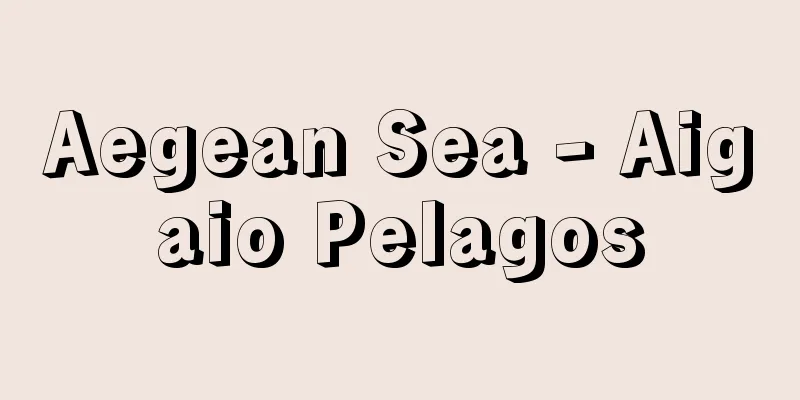Aegean Sea - Aigaio Pelagos

|
The sea area in the eastern Mediterranean Sea. English name: Aegean Sea. It is bounded to the east by the coastal islands of Asia Minor, to the south by Crete, to the west by the Greek Peninsula, and to the north by Macedonia and Thrace. It connects to the Sea of Marmara via the Strait of Çanakkale in the northeast. There are 400 islands, large and small, scattered over the sea surface of 640 km north to south and 320 km east to west, and it is also called the Sea of Archipelago. The name Archipelago, meaning archipelago, was originally used only for the Aegean Sea. The name Aegean comes from the legendary King Aegeus of Athens or Aigai, a sacred place of the sea god Poseidon. As Herodotus likened the islands of the Aegean Sea to the floating villages on the surface of the water when the Nile River floods, most of the islands are the tops of old submerged landmasses, and several rows of new orogenic belts run through it in an east-west direction. The ocean floor topography is complex, with deep sea areas nearly 2,300 meters deep and shallow sea areas only a few tens of meters deep. The Aegean civilization arose around 2000 BC around this area, and it became the heart of Greek culture in the late ancient period, because it is safe and easy to navigate without losing sight of the islands, and the whole area is located at the contact point between Asia and Europe, and is close to Egypt, where ancient civilization flourished. As Plato likened it to a frog around a pond, the ancient Greeks lived along the coast of this sea. As it was a key transportation point, it continued to be a battleground for the surrounding ethnic groups in the Middle Ages and modern times. After being ruled by Rome, the Byzantine Empire, the Crusaders, and Venice, most of the islands fell into the hands of the Ottoman Empire as a result of the Venetian-Turkish wars in the 15th and 16th centuries, but after the independence revolution of 1821, the Sporades and Cyclades became Greek territories when the Kingdom of Greece was established (1832), and Crete and the Dodecanese islands were annexed to Greece in 1913. With their warm climate and beautiful scenery, the islands have become popular tourist resorts in recent years. However, due to factors such as rough seas in winter that stop transportation, development has lagged behind and many areas still retain their traditional customs and habits. [Keiji Baba and Tomoko Mashita] [References] |Source: Shogakukan Encyclopedia Nipponica About Encyclopedia Nipponica Information | Legend |
|
地中海東部の海域。英語名Aegean Sea。東は小アジア沿岸諸島、南はクレタ島にくぎられ、西はギリシア半島、北はマケドニアおよびトラキア地方に囲まれる。北東部のチャナッカレ海峡を経てマルマラ海に通じる。南北640キロメートル、東西320キロメートルの海面に大小あわせて400の島が散在し、一名多島海ともよばれる。群島を意味するArchipelagoという名称は最初はエーゲ海に限って用いられた。エーゲの名称は伝説上のアテネ王アイゲウスか、もしくは海神ポセイドンの聖地アイガイに由来する。ヘロドトスがエーゲ海の島々を、ナイル川氾濫(はんらん)の際に水面に点々と浮かぶ集落のようすに例えたように、島嶼(とうしょ)の大部分は沈水した旧陸塊の頂上部にあたり、さらに東西方向に数列の新期造山帯がこれを貫いている。海底の地形は複雑で、水深2300メートル近い深海もあれば、深さ数十メートルの浅海もある。 島影を見失わずに安全かつ容易に航海できること、海域全体がアジアとヨーロッパとの接触点に位置を占め古代文明の開花したエジプトにも近いことなどから、紀元前2000年ごろよりこの海域を中心としていわゆるエーゲ文明が興り、古代後期にはギリシア文化の心臓部となった。プラトンが池の周りにいるカエルに例えたように、古代ギリシア人はこの海の沿岸を生活の舞台とした。交通上の要地であるため、中世、近代には周辺民族の争闘の場であり続けた。ローマ、ビザンティン帝国、十字軍、ベネチアの支配ののち、15、16世紀のベネチア・トルコ戦争の結果ほとんどすべての島が順次オスマン・トルコ帝国の手中に落ちたが、1821年の独立革命により、スポラデス諸島とキクラデス諸島はギリシア王国成立(1832)とともにギリシア領となり、クレタ島とドデカネス諸島は1913年にギリシアに帰属した。気候温暖、風光明媚(めいび)な島々は、近年、観光保養地として人気を集めているが、他方、冬は海が荒れて交通がとだえるなどの理由からいまだに開発が遅れ、伝統的な風俗習慣を残している地方も多い。 [馬場恵二・真下とも子] [参照項目] |出典 小学館 日本大百科全書(ニッポニカ)日本大百科全書(ニッポニカ)について 情報 | 凡例 |
<<: Egeyama ruins - Egeyama ruins
>>: Eclogite - Eclogite (English spelling)
Recommend
Basutoland
...Since 1835, the border was constantly threaten...
Bazhov
Bulgarian writer. He is a central figure in Bulgar...
Fabricius
German theologian and astronomer. In 1596, he disc...
Raphidae
…A general term for birds of the family Raphidae ...
Selection of Imagist Poets
…Through these efforts, Imagism gained more follo...
Sotaro Araki
A Nagasaki red seal ship trader active in the ear...
Troy
An ancient city in northwest Asia Minor. Also know...
Imibiozen - Imibiozen
...At Ise Shrine, sacred offerings are cooked in ...
Schwäbische Alb
A mountain range stretching from southwest to nort...
Yellow-legged wasp - Yellow-legged wasp
...They hunt moth larvae and store them in their ...
Amphipithecus
...This period can be said to be the period of ad...
Small Song and Dance - Kota Dance
It belongs to the Furyu dance genre of folk perfo...
Bronchoscope - Bronchoscope
A medical instrument used to see the inside of the...
epigram
(1) epigramma A type of poetry in ancient Greece a...
Benign prostatic hyperplasia
What kind of disease is it? Main symptoms and prog...









